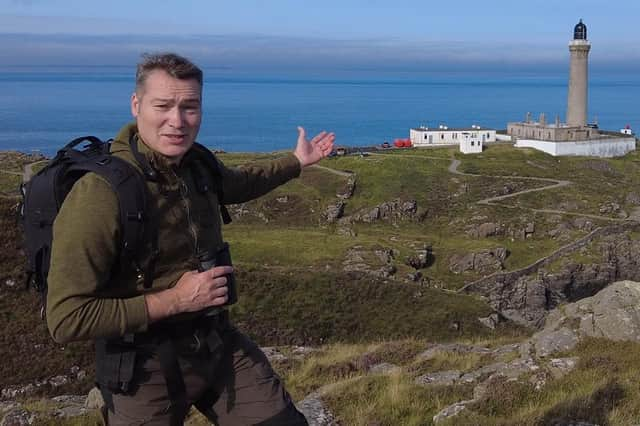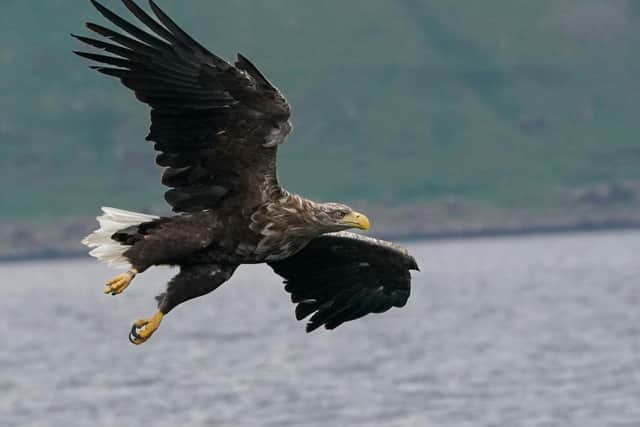North Yorkshire wildlife artist Robert E Fuller is on the trail of sea eagles in the Scottish Highands


Situated at the most westerly point of mainland UK, it is home to a host of different wildlife species.
The harbour seals, also known as common seals, are among my favourite and whenever I visit I take a canoe out to see them. They spend most of their time out at sea feeding on fish, but when they return to land to rest and warm up they like to bask.
Advertisement
Hide AdAdvertisement
Hide AdThey don’t really do that much, but when they do it’s often really comical. They are such fun to watch, even if they are only scratching themselves or rolling over.


Another mammal that thrives in these waters is the otter. These animals are extremely shy. It can take days to get a good sighting and then it is important to stay really low, and keep still, only moving when the otter dives. They typically dive for about 30 to 40 seconds, so you don’t get long. And if they detect movement or pick up a scent when they resurface, they will suddenly vanish.
I often try to watch otters from land, sneaking into position before they surface, hopefully with a catch. Crab is one of their favourite food and it’s amazing to watch them crunch through the hard shells.
I’ve watched them on many visits to this part of Scotland, and was once lucky enough to watch a mother grooming her cub. She was so tender in the way she curled around the youngster protectively.
Advertisement
Hide AdAdvertisement
Hide AdBut up in the skies above is one of the rarest residents of these shores: the white-tailed eagle. Also known as a sea eagle, this is the UK’s largest bird of prey. With a wingspan that can spread over eight feet, this bird has been famously described as like a ‘flying barn door’.
A massive and impressive bird of prey, its wings are broader than those of a golden eagle, which also live in Ardnamurchan.
White-tailed eagles were persecuted to extinction in the UK but reintroduced from Norway during the 1970s. Today, they now nest in large numbers in Scotland.
They feed on fish and birds or mammals. Adults have a white, wedge-shaped tail and a pale head with a yellow bill. They are more likely to be found near the coast than the golden eagle.
Advertisement
Hide AdAdvertisement
Hide AdThey can be easy to spot since they spend much of their time perching on open trees or dead branches, where there is space for their wings as they land or take off, watching for hunting opportunities.
These birds can spend hours on their shoreline perches simply watching the sea for ripples that might indicate the presence of fish or for birds flocking around the water which also indicate that there are fish to be had.
Adept at hunting both at sea and on land, they’ve been known to take deer calves. And I’ve seen them pinch food from otters before. Watching a white-tailed eagle fish is an incredible experience and something I’ve always wanted to film up close.
On my last visit to the region, I decided to charter a boat with a guide who specialised in white-tailed eagles. Martin Keivers runs Mull Charters from the Isle of Mull.
Advertisement
Hide AdAdvertisement
Hide AdAlong with his son Alex, he has spent years getting to know the sea eagles living on these shores. So, I took a ferry across from Ardnamurchan to meet him.
Martin and Alex met me at the Ulva ferry terminal and from there we headed up Loch Tuath. It was a beautiful sunny day and the sea was so calm it mirrored the surrounding mountains.
We had barely left the harbour and I was still sorting through my camera gear, when Alex called: “Eagle,” and pointed to an eagle flying towards us from the Isle of Ulva.
It was heading straight to our boat. As it got closer, I got a real sense of scale. The bird began to circle our boat, the full length of its wings outstretched. It was so close I could hear every wing beat.
Advertisement
Hide AdAdvertisement
Hide AdAlex threw a fish into the sea and the eagle momentarily positioned itself against the wind before pitching to a dramatic stoop. Then, as it approached the water it adjusted its wings.
Its legs dropped, like an aircraft’s landing gear coming in to land. Its huge talons were the size of a man’s hand; the claws two inches long.
I was so busy concentrating on this amazing spectacle, I hadn’t even noticed its mate overhead, a male just fractionally smaller in size.
Then, before I could take in what I had just seen, the male was also stooping. Alex had thrown it a fish and instantly it had it in its claws and was following the female back to the shore.
Advertisement
Hide AdAdvertisement
Hide AdI followed the line of their flight with my binoculars and noticed one of their young was waiting for them in a birch tree on the island. Sea eagles work together as a pair to tend to the one or two chicks that hatch each year.
As these parent birds got closer, their youngster became more and more excited, flying from tree to tree and calling as it begged for food.
We sailed on, heading around the Isle of Ulva, and as we did so, a further two pairs of eagles arrived and performed the same spectacular fly-ins.
As we rounded the Isle of Mull, leaving Loch Tuath and heading towards the open sea, we were joined by a huge pod of dolphins, riding the waves by our boat.
Advertisement
Hide AdAdvertisement
Hide AdDolphins are agile and inquisitive creatures and often follow boats for fun. This pod was obviously enjoying the bow wave of the boat and the dolphins were jumping and spinning their long bodies in the water. Even the young came next to our boat.
As we sailed back into port, I thought about how much I had seen and all the amazing wildlife encounters I had had in such a short space of time in this spectacular region of Scotland.
*Robert’s paintings and live nest cameras are on show at his gallery in Thixendale. Go to robertefuller.com for opening times. View wildlife footage at youtube.com/c/robertefuller